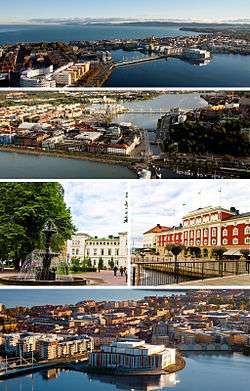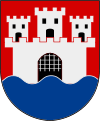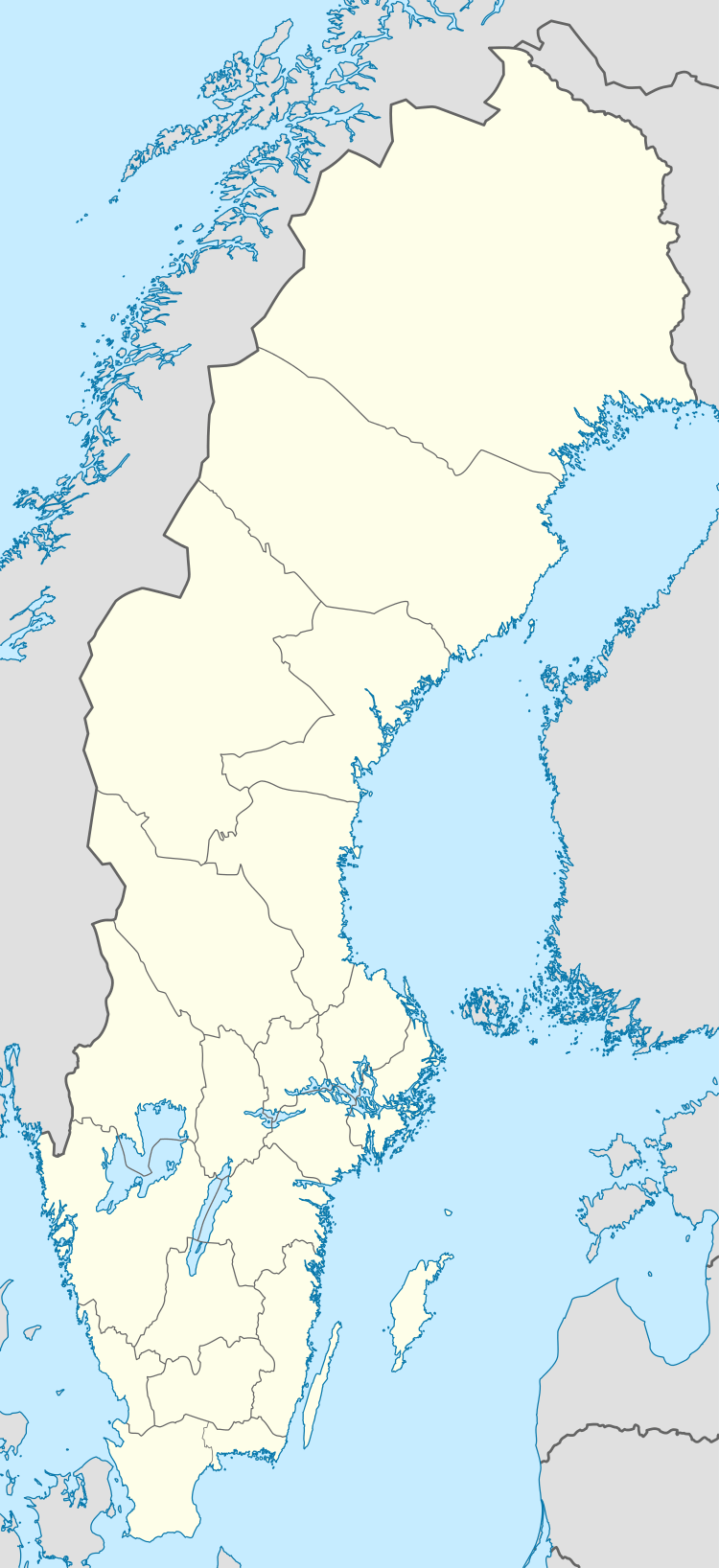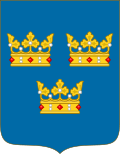Jönköping
Jönköping (/ˈjɜːn(t)ʃɜːpɪŋ/,[3][4] Swedish: [ˈjœ̂nːˌɕøːpɪŋ] (![]()
Jönköping | |
|---|---|
 Collage of Jönköping | |
 Coat of arms | |
 Jönköping  Jönköping | |
| Coordinates: 57°46′58″N 14°09′38″E | |
| Country | Sweden |
| Province | Småland |
| County | Jönköping County |
| Municipality | Jönköping Municipality |
| City status | 1284 |
| Area | |
| • City | 44.82 km2 (17.31 sq mi) |
| Elevation | 104 m (341 ft) |
| Population (31 December 2015)[1] | |
| • City | 93,797 |
| • Density | 2,100/km2 (5,400/sq mi) |
| • Metro | 134,785[2] |
| Time zone | UTC+1 (CET) |
| • Summer (DST) | UTC+2 (CEST) |
| Postal code | 551 xx |
| Area code(s) | (+46) 36 |
| Vehicle registration | 1544 |
| Climate | Dfb |
| Website | www |
The city is the seat of Jönköping Municipality, which has a population of 141 081 (2019) and is Småland's most populous municipality.[6] Jönköping is also the seat of Jönköping County which has a population of 363 599 (2019).[7] Jönköping is the seat of a district court and a court of appeal as well as the Swedish National Courts Administration. It is the seat of the Swedish Board of Agriculture.[8]
History

Jönköping is an old trading centre (Köping) situated at a natural crossroads for routes following the rivers Nissan and Lagan, and the road connecting the provinces of Östergötland and Västergötland, a result of the town's geographical position at the southern end of lake Vättern, which divides the two provinces.
On 18 May 1284 Jönköping became the first City in Sweden to be granted its rights by king Magnus Ladulås, who ruled mostly from Vättern's largest island Visingsö. The first part of the city's name, "Jön", is derived from a creek, "Junebäcken", in Talavid, in what is now the western part of the city. The second part of the name "köping", is, as mentioned above, an old word for a trading centre or market place.[9]
The geographical position of the city also left it vulnerable to attack via the river routes that led south, mainly from Danes. At that time the provinces of what is today southern Sweden — Scania, Halland and Blekinge — belonged to Denmark. The city was plundered and burned several times until it was fortified during the 16th and 17th centuries.
Jönköping was known for its matchstick industry between 1845–1970.[10] The phosphorus match was invented in 1831, and these matches became very popular because one could strike it against any surface to ignite it. However, the problem was that they ignited too easily, caused a lot of accidents and was toxic. In 1844, Swedish professor Gustav Erik Pasch patented a new invention, ”Safety matches - Strike against the box only”.[11] To prevent the matches from igniting so easily, Gustav Erik Pasch separated the chemicals in the match head and placed the phosphorus on a separate surface on the outside of the box for striking ignition. Johan Edvard and Carl Frans Lundström took Pasch's patent and improved it. Later, they manufactured their new Safety matches in their factory in Jönköping.[12] Today it is an important Nordic logistical center, with many companies' central warehouses (such as Elkjøp, IKEA, Electrolux and Husqvarna) situated there.
Present
The urban area of Jönköping today includes the eastern industrial town of Huskvarna, with which it has grown together.
Elmia, a major trade fair and exhibition centre, is situated in Jönköping. Elmia Wood is the world’s largest forestry fair, and those for subcontractors, trucks, caravans and railways are the biggest of their kind in Europe. Since 2001, Elmia has been the site of the world's largest LAN party, DreamHack, with two events every year, Dreamhack Summer and Dreamhack Winter.
Demography
Population
As of 2018, Jönköping has a total population of 139,222.[13]
| Gender | 2014 | 2015 | 2016 | 2017 | 2018 | 2019 |
|---|---|---|---|---|---|---|
| Female | 66,404 | 66,987 | 67,823 | 68,722 | 69,426 | 70,265 |
| Male | 65,736 | 66,323 | 67,474 | 68,759 | 69,796 | 70,816 |
| Total | 132,140 | 133,310 | 135,297 | 137,481 | 139,222 | 141,081 |
Population changes
| 2014 | 2015 | 2016 | 2017 | 2018 | 2019 | |
|---|---|---|---|---|---|---|
| Population increase | 1,342 | 1,170 | 1,987 | 2,184 | 1,741 | 1,859 |
| Born | 1,677 | 1,662 | 1,715 | 1,615 | 1,688 | 1,644 |
| Deceased | 1,169 | 1,217 | 1,101 | 1,202 | 1,253 | 1,100 |
Average age 2019
| Area | Female | Male | Female and Male |
|---|---|---|---|
| Jönköping | 41.3 | 39.2 | 40.3 |
Notable people
- John Bauer, illustrator, painter
- Amy Diamond, singer
- Agnetha Fältskog, singer/songwriter and member of ABBA
- Carl Henrik Fredriksson, editor-in-chief and co-founder of Eurozine
- Anders Gustafsson, kayaker, Olympian
- Dag Hammarskjöld, former United Nations Secretary-General
- I'm from Barcelona, 29-piece indie pop band
- Mona Johannesson, model
- Carl Theofil Gustafson-Lotave, artist, portrait painter
- Per G. Malm, leader in The Church of Jesus Christ of Latter-day Saints
- The Mary Onettes, indie rock band
- The Motorhomes, rock band
- Fredrik Neij, founder of The Pirate Bay BitTorrent-tracker
- Nina Persson, vocalist with The Cardigans
- Göran Kropp, mountaineer
- Sofia Paldanius, kayaker, Olympian
- Johan Björnsson Printz, governor of the Swedish colony of New Sweden
- Viktor Rydberg, author
- Vladimir Oravsky, author
- Aurore Storckenfeldt (1816–1900), educator
- Swante M. Swenson, founder of the SMS ranches in Texas
- Carl Peter Thunberg, botanist
- Stefan Liv, ice hockey goaltender
- Martin Allwood, translator
- David F. Sandberg, film director
- Klas Bernhard Johannes Karlgren, sinologist and linguist
Education
High schools
- Bäckadalsgymnasiet
- Erik Dahlbergsgymnasiet
- Per Brahegymnasiet
- Sandagymnasiet
- LBS: High School of Creativity
Tertiary education
- Jönköping University Foundation
- Södra Vätterbygdens Folkhögskola
- The Institute for Postgraduate Dental Education
Climate
Jönköping's climate was humid continental (Köppen Dfb) with long, cold winters and short, warm summers during the 1961–1990 period. However, the window between subarctic and oceanic is very small in this marine-influenced climate type, and in recent years the climate has more resembled very cold oceanic. However, figures are slightly skewed due to the weather station being located at the airport which is at an elevation of 228 metres (748 ft), whereas the city centre is at 100 metres (330 ft). This likely renders up to between half a degree to a full degree milder temperatures in the urban centre.
| Climate data for Jönköping Airport 2002–2018; extremes since 1901 | |||||||||||||
|---|---|---|---|---|---|---|---|---|---|---|---|---|---|
| Month | Jan | Feb | Mar | Apr | May | Jun | Jul | Aug | Sep | Oct | Nov | Dec | Year |
| Record high °C (°F) | 10.5 (50.9) |
14.7 (58.5) |
18.7 (65.7) |
26.3 (79.3) |
28.6 (83.5) |
33.2 (91.8) |
33.4 (92.1) |
34.2 (93.6) |
26.8 (80.2) |
21.4 (70.5) |
14.1 (57.4) |
12.6 (54.7) |
33.4 (92.1) |
| Mean maximum °C (°F) | 6.4 (43.5) |
6.6 (43.9) |
13.1 (55.6) |
18.8 (65.8) |
24.4 (75.9) |
26.7 (80.1) |
28.2 (82.8) |
27.1 (80.8) |
22.4 (72.3) |
16.0 (60.8) |
10.5 (50.9) |
7.4 (45.3) |
29.6 (85.3) |
| Average high °C (°F) | 0.2 (32.4) |
0.7 (33.3) |
4.6 (40.3) |
11.0 (51.8) |
16.3 (61.3) |
19.5 (67.1) |
21.9 (71.4) |
20.3 (68.5) |
16.3 (61.3) |
9.8 (49.6) |
5.0 (41.0) |
2.0 (35.6) |
10.6 (51.1) |
| Daily mean °C (°F) | −2.5 (27.5) |
−2.3 (27.9) |
0.4 (32.7) |
5.4 (41.7) |
10.3 (50.5) |
13.7 (56.7) |
16.4 (61.5) |
15.2 (59.4) |
11.7 (53.1) |
6.4 (43.5) |
2.6 (36.7) |
−0.5 (31.1) |
6.4 (43.5) |
| Average low °C (°F) | −5.2 (22.6) |
−5.2 (22.6) |
−3.9 (25.0) |
−0.2 (31.6) |
4.3 (39.7) |
7.9 (46.2) |
10.8 (51.4) |
10.1 (50.2) |
7.0 (44.6) |
3.0 (37.4) |
0.2 (32.4) |
−2.9 (26.8) |
2.2 (35.9) |
| Mean minimum °C (°F) | −18.1 (−0.6) |
−16.1 (3.0) |
−14.2 (6.4) |
−7.3 (18.9) |
−3.3 (26.1) |
1.0 (33.8) |
4.7 (40.5) |
2.2 (36.0) |
−1.3 (29.7) |
−5.7 (21.7) |
−9.4 (15.1) |
−13.6 (7.5) |
−21.6 (−6.9) |
| Record low °C (°F) | −33.0 (−27.4) |
−35.4 (−31.7) |
−30.0 (−22.0) |
−18.1 (−0.6) |
−7.2 (19.0) |
−1.4 (29.5) |
0.2 (32.4) |
−2.3 (27.9) |
−7.3 (18.9) |
−13.3 (8.1) |
−20.7 (−5.3) |
−28.3 (−18.9) |
−35.4 (−31.7) |
| Average precipitation mm (inches) | 43.2 (1.70) |
32.0 (1.26) |
27.7 (1.09) |
29.9 (1.18) |
48.3 (1.90) |
79.4 (3.13) |
80.4 (3.17) |
85.6 (3.37) |
50.4 (1.98) |
58.0 (2.28) |
52.1 (2.05) |
49.5 (1.95) |
636.5 (25.06) |
| Source 1: SMHI Average Data 2002–2018[14] | |||||||||||||
| Source 2: SMHI Open Data[15] | |||||||||||||
Sport
- HV71, ice hockey team in Swedish Hockey League of ice hockey.
- Jönköpings IK (JIK), floorball team who has played several season in the men's Swedish Super League.
- Jönköpings Södra IF, football (soccer) team in Superettan (second tier league of Sweden).
- Husqvarna FF, football (soccer) team in Division 1 (third tier league of Sweden).
- IK Tord, football (soccer) team in Division 2 Västra Götaland (fourth tier league of Sweden).
- Jönköping Bandy IF, bandy team in Allsvenskan (second tier league of Sweden).
- Jönköpings SS, swimming society, with Swedish champions in both swimming and diving. There are also three other water disciplines in the club, lifeguarding and synchronized swimming.
- ATP Challenger Tour event, starting in 2016.[16]
- Jönköping hosted the 1984 World Rowing Junior Championships and the 2019 European Universities Rowing Championships.
See also
- Jönköping Municipality
- Swedish National Board of Agriculture
- International Ice Hockey Federation World Championships (2002, held in Jönköping)
- Tranhult
References
- "Population in the country, counties and municipalities by sex and age". Statistics Sweden. 27 May 2013. Archived from the original on 16 January 2013.
- http://www.scb.se/hitta-statistik/statistik-efter-amne/befolkning/befolkningens-sammansattning/befolkningsstatistik/pong/tabell-och-diagram/kvartals--och-halvarsstatistik--kommun-lan-och-riket/kvartal-3-2016/
- "Jönköping" (US) and "Jönköping". Oxford Dictionaries UK Dictionary. Oxford University Press. Retrieved 8 March 2019.
- "Jönköping". Merriam-Webster Dictionary. Retrieved 8 March 2019.
- http://www.statistikdatabasen.scb.se/pxweb/sv/ssd/START__MI__MI0810__MI0810A/LandarealTatort/?rxid=8f5b9e8f-3a94-4ca6-8b53-c3ce838a7d6a
- "Befolkningsstatistik". Jönköpings Kommun. Retrieved 4 April 2020.
- "Folkmängd efter region och år". Statistiska Centralbyrån. Retrieved 4 April 2020.
- "Swedish Board of Agriculture – How to find our headquarters". Swedish Board of Agriculture. Archived from the original on 28 September 2011. Retrieved 21 June 2011.
- Wahlberg, Mats, ed. (2003). Svenskt ortnamnslexikon (PDF) (in Swedish) (1st ed.). Uppsala: Swedish Institute for Dialectology, Onomastics and Folklore Research. p. 158. ISBN 91-7229-020-X. Retrieved 22 January 2017.
- Ohlsen, Becky; Kaminski, Anna; Lundgren, K (1 June 2012). Lonely Planet Sweden (5th ed.). Lonely Planet. ISBN 978-1741797268.
- Wisniak, Jaime (May 2005). "Matches-The manufacture of fire". CSIR. 12 (3): 369–380 – via NISCAIR.
- "History of matches". Swedish Match. Retrieved 21 April 2019.
- "Befolkningsstatistik". Jönköpings Kommun. Retrieved 5 April 2020.
- "Monthly & Yearly Statistics". SMHI. Retrieved 28 June 2019.
- "SMHI öppna data för Huskvarna". SMHI. Retrieved 30 June 2019.
- "Jonkoping Challenger 2016 Feature | ATP Tour | Tennis".
External links
| Wikimedia Commons has media related to Jönköping. |

- Official website
- article Jönköping from Nordisk familjebok, (in Swedish)

